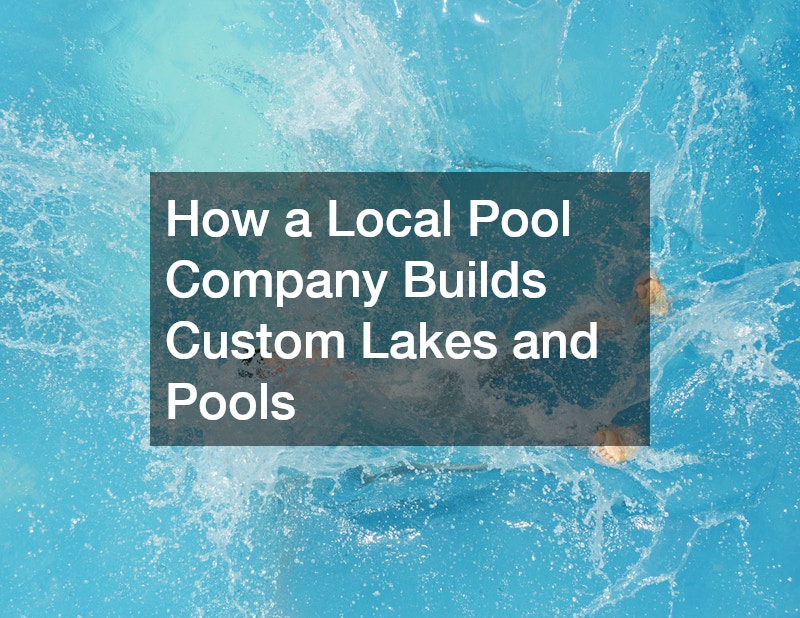This article explores the processes and techniques that a local pool company employs to construct custom lakes and pools, addressing common questions and concerns from homeowners.
What are the steps involved in designing a custom pool or lake?
The journey begins with an initial consultation where homeowners discuss their vision with the pool company. During this meeting, they can express their desires regarding aesthetics, features, and functionality, ensuring that the project aligns with their lifestyle and preferences.
Additionally, the pool company gathers information about the property and explores various design possibilities tailored to the location.
Next, the pool company creates preliminary sketches based on the homeowner’s input. These designs showcase layout options, depth variations, and unique features such as waterfalls or fountains. Homeowners are encouraged to provide feedback, and adjustments are made to ensure satisfaction with the proposed vision. This collaborative approach sets the foundation for a successful project.
Once the design is finalized, a detailed proposal with timelines, budget estimates, and materials is presented. Homeowners review the plan, considering the financial investment and potential outcomes. After approvals, the project transitions into the construction phase, where the actual work begins with site preparation and excavation, bringing the dream of a custom pool or lake to life.
What materials are typically used in constructing pools and lakes?
The choice of materials greatly influences the functionality and aesthetics of a pool or lake. Concrete is a popular option for those looking for durability and customizable shapes. This versatile material allows for a wide variety of design elements, making it suitable for any homeowner’s unique vision. It’s known for its longevity, but it requires proper installation and maintenance to maximize its lifespan.
Fiberglass pools, on the other hand, offer a quick installation process and low maintenance requirements. These pre-molded structures come in various shapes and sizes, providing homeowners with an efficient alternative to traditional materials. Their smooth surface minimizes algae growth, making them an attractive option for those seeking a hassle-free aquatic experience.
Natural elements, such as rocks, plants, and even natural filtration systems, can be integrated into custom lakes to enhance the ambiance and ecological balance. Using native materials not only accentuates the surrounding landscape but also provides habitats for local wildlife. This approach blends the pool or lake into the environment, creating a seamless transition between the aquatic feature and the natural landscape.
How does a local pool company ensure environmental sustainability in their projects?
A local pool company often employs water management techniques to promote sustainability in their projects. Implementing efficient drainage systems and rainwater harvesting can significantly reduce water wastage. By capturing and recycling water, homeowners can enjoy their pool or lake while contributing to environmental preservation, an essential aspect in today’s eco-conscious world.
Additionally, eco-friendly materials are increasingly becoming a priority in pool construction. Many pool companies now source sustainable products that minimize environmental impact, such as low-VOC paints and biodegradable filtration systems. By utilizing these materials, they ensure that their projects are not only beautiful but also aligned with sustainable practices.
Finally, the use of advanced technology, such as solar pool heaters and LED lighting, can significantly decrease energy consumption. By integrating renewable energy solutions, pool companies help homeowners lower their carbon footprint. These innovations not only promote sustainability but also lead to long-term savings on utility costs, demonstrating a commitment to both quality and environmental stewardship.
What are the maintenance requirements for custom lakes and pools?
Proper maintenance is crucial for keeping custom lakes and pools functional and visually appealing. Regular cleaning and chemical balancing are essential to ensure water quality and prevent algae growth. Homeowners should establish a routine that includes skimming leaves, vacuuming the pool floor, and testing water chemistry to maintain a safe swimming environment.
Seasonal maintenance is also important to prepare the pool or lake for changing weather conditions. This may include winterizing the pool, covering it to prevent debris accumulation, and monitoring water levels. By staying proactive, homeowners can prevent costly repairs and extend the life of their pools and lakes.
Engaging professional maintenance services can further ease the burden on homeowners. Many pool companies offer comprehensive maintenance packages that include cleaning, chemical treatments, and equipment inspections. By investing in professional care, homeowners can enjoy their aquatic spaces without the stress of ongoing upkeep, allowing for more leisure time with family and friends.
Understanding how a local pool company builds custom lakes and pools can empower homeowners to make informed decisions about their aquatic designs. By deciphering the steps involved in creating these features, recognizing the materials available, and acknowledging the importance of sustainability and maintenance, homeowners can lead to enjoyable and sustainable outdoor environments that enhance their properties.
